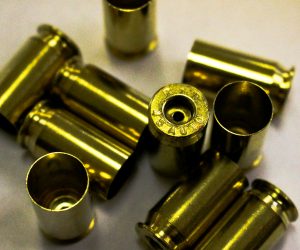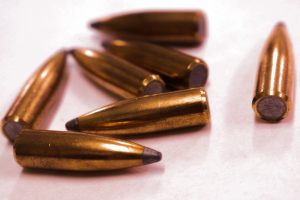Cartridge Parts—The New Shooter’s Dictionary
Cartridge Parts
Shooting seems pretty simple. You stuff some of those shiny brass-colored thingys into your pistol or rifle, aim carefully at the target, squeeze the trigger—Ka-BOOM!—and you check the target to see where you’ve hit. But what is it exactly that happens when the trigger is tripped? What mystical formula takes your bullet from gun chamber to target? Let’s take a look at what comprises the metallic cartridge!
- The Cartridge Case—This is a simple container designed to house the other three components of a loaded cartridge. It is generally machined of brass (and may be covered in nickel at times) so as to be malleable. It can be reformed and reused by a reloader or handloader (one who makes their own centerfire rifle and pistol rounds or shotgun shells) and is the only component of a cartridge that can be reused.

Photo by Philip J. Massaro
Once the cartridge has been fired, shooters will often refer to the spent case as “brass.” If you are shooting at a public range, you may hear the range officer say “Police your brass, please.” That simply means that you are required to pick up the spent cases. Being a handloader, I hoard all the spent centerfire cases I can, rimfire cases can’t be reloaded). On your brass case you’ll find the name/caliber of the cartridge impressed in the “case head,” the flat portion of the case opposite the bullet end. Why is this important? You want to make absolutely certain that the impression exactly matches the caliber markings on your firearm. Many cartridges appear nearly identical to one another, but they will not be interchangeable for use in your gun.
- The Primer—This little round metal cup located in the center of the case head for centerfire cartridges is the device that ignites the powder charge in the case. The primer contains a compound that creates a shower of sparks when it is crushed by your firearm’s firing pin. One word of warning regarding the primer of a cartridge: They are set off by the impact of the firing pin, so they can also be set off by a hard impact by any sharp object. Always handle cartridges with care, especially rimfire cartridges, whose priming compound is contained in the entire rim of the cartridge base.
 The Powder Charge—This is the source of your Ka-BOOM. It is a highly flammable substance, based on nitrocellulose. Powder is loaded in the cartridge in precise amounts, to generate a specific velocity and pressure. As with the proverbial cat, curiosity may tempt you to dismantle a case to examine the powder charge. You should never do this, as the smallest of sparks will ignite the powder, and create a very dangerous situation.
The Powder Charge—This is the source of your Ka-BOOM. It is a highly flammable substance, based on nitrocellulose. Powder is loaded in the cartridge in precise amounts, to generate a specific velocity and pressure. As with the proverbial cat, curiosity may tempt you to dismantle a case to examine the powder charge. You should never do this, as the smallest of sparks will ignite the powder, and create a very dangerous situation.- The Bullet—This is the only part of a cartridge that ever touches the target or a game animal. Bullets are also called “projectiles” in military terminology. They come in many shapes and sizes and are of a diameter specific to the bore of the firearm.
So what is it about these four parts that gets you the Ka-BOOM? Here’s how these parts work together. Once the firing pin strikes the primer, the shower of sparks the primer produces inside the brass case ignites the powder charge. The resulting rapid burn of the powder creates huge pressure, because all that hot gas is still inside the case and behind the bullet. That pressure will eventually (with a fraction of a second, actually) push the bullet out of the brass case and into your gun’s barrel. There the bullet engages the barrel’s “rifling,”—that twisting groove you can see when you’re inspecting your unloaded gun after cleaning—which forces the bullet to spin. This spinning is beneficial because it balances the bullet in flight, much like a spiraling football flies true when it’s thrown by a strong-armed quarterback. If you’ve done your part with trigger control, sight alignment and proper breathing, your bullet should hit right where you were aiming.